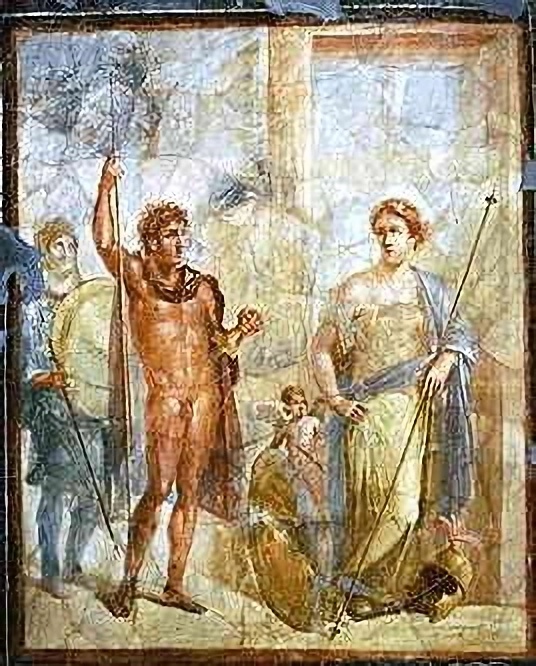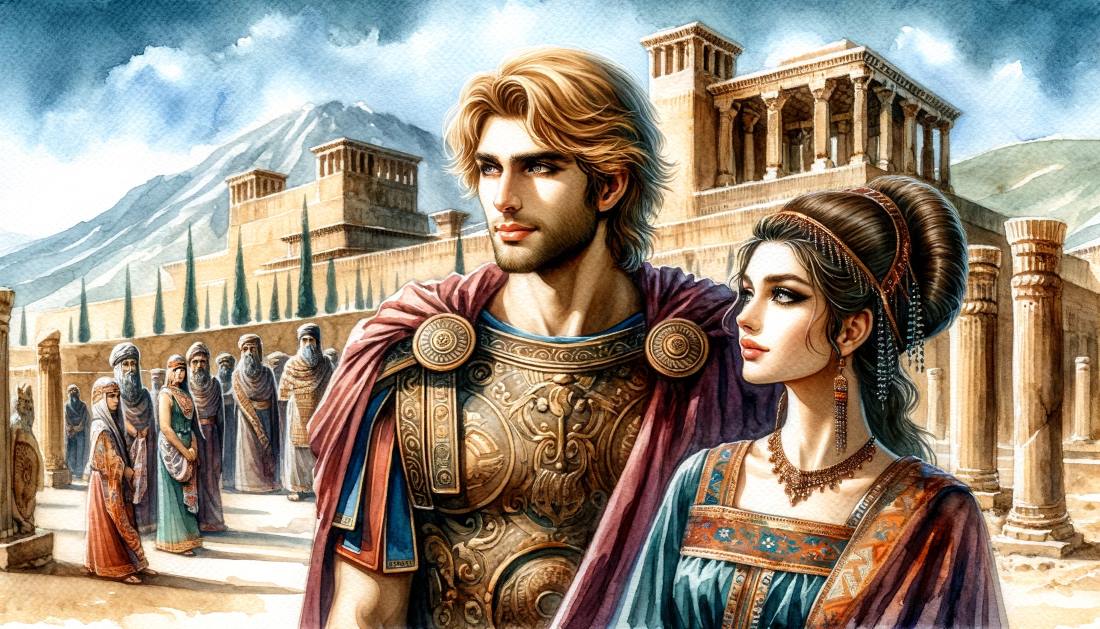Alexander the Great, known for his monumental conquests and the establishment of a vast empire, had a personal life as intriguing as his military campaigns. He took the role of a husband three times, each marriage aligning with his strategic and political aspirations. The wives of Alexander the Great, though often overshadowed by his military exploits, played significant roles in his life and legacy. Further, Alexander fathered two sons, each born to different mothers, adding layers to his complex familial relationships. This blog post explores these personal aspects of Alexander, revealing how his marriages and progeny were intertwined with the narrative of an empire builder.
Roxana the Beloved Wife of Alexander the Great and Alexander IV
Roxana, a figure of enchanting beauty and profound influence, emerges as a prominent wife of Alexander the Great. Born into the noble Sogdian lineage, she crossed paths with Alexander after his conquest of Sogdia in 327 BC. Their union was not just a matter of political convenience but also one of deep romantic connection. Renowned for her striking charm and intelligence, Roxana quickly ascended to a place of favor in Alexander’s life, distinguishing herself among his spouses. Their marriage, steeped in both love and strategic significance, played a pivotal role in Alexander’s efforts to integrate the diverse cultures within his empire.

Tragically, the story of Roxana intertwines with the fate of her son, Alexander IV. Born in 323 BCE, in the immediate aftermath of Alexander the Great’s expansive campaigns, Alexander IV was thrust into a world of political complexity from his earliest days. As the legitimate heir to Alexander’s empire, his very existence was a symbol of the continuity of his father’s legacy. However, the young prince’s life was overshadowed by the power struggles that erupted following Alexander’s death. The regency and guardianship during his childhood were marred by the ambitions of Alexander’s generals and advisers, who sought to use the young heir as a pawn in their quests for power. Alexander IV’s life, a blend of royal privilege and political vulnerability, was a testament to the turbulent era he was born. His premature death at the age of approximately 13 not only marked a tragic end to his short life but also symbolized the end of Alexander the Great’s direct bloodline, altering the course of history in the Hellenistic world.
Heracles: The Shadowed Legacy of Alexander the Great
Heracles of Macedon, often cited as an illegitimate son of Alexander the Great, was born to Barsine, daughter of Satrap Artabazus, around 327 BC. His status as Alexander’s son has been a subject of debate among historians due to the varying accounts of ancient sources. For instance, while Plutarch and Justin mention Heracles, Arrian’s detailed chronicles of Alexander’s conquests make no reference to him or his mother Barsine. Mary Renault, a noted historian, further questions his legitimacy by pointing out the absence of any contemporary mention of Barsine or Heracles during Alexander’s lifetime.
The mystery of Heracles’ lineage becomes more intriguing when considering the power dynamics after Alexander died in 323 BC. Despite being a potential heir, Heracles was not immediately involved in the succession disputes, overshadowed by Philip Arrhidaeus and later Alexander IV. It wasn’t until the murder of Alexander IV in 310 or 309 BC that Heracles’ name resurfaced, championed by Polyperchon, a former regent of Macedon. This led to a brief but significant confrontation with Cassander, Alexander’s general who had taken control. In a twist of political intrigue, Cassander bribed Polyperchon to betray Heracles, resulting in the latter’s death.
The Other Wives of Alexander the Great: A Blend of Cultures
In addition to Roxana, Alexander the Great’s matrimonial alliances extended to several other women, notably during his time in Susa in 324 BCE. This period marked a significant shift in Alexander’s approach to consolidating his empire, as he orchestrated an unprecedented mass wedding ceremony. In this grand event, Alexander himself married two Persian noblewomen, symbolizing a strategic blend of cultures. Among them was Stateira, the eldest daughter of Darius III, the defeated Persian emperor. This marriage was not only a powerful political gesture but also a step towards integrating the Macedonian and Persian cultures, a vision Alexander ardently pursued.

The other woman to become Alexander’s wife at this time was Parysatis. This wedding, along with the marriages of about 90 of his officers and friends to women of Persian royalty, was a deliberate effort by Alexander to meld the Macedonian and Persian elites. These unions were intended to forge a new ruling class that would govern his expansive empire, one that combined both Asian and European ancestries. However, this act, meant to symbolize unity and consolidation, was met with mixed reactions. While it demonstrated Alexander’s ambition to fuse different cultures, it also sparked discontent among those who viewed it as a departure from traditional Macedonian customs. This blend of marriages underscored Alexander’s far-sighted strategy for a unified empire, a goal that remained central to his vision until his untimely death.
Historical Challenge: Can You Conquer the Past?
Answer more than 18 questions correctly, and you will win a copy of History Chronicles Magazine Vol 1! Take our interactive history quiz now and put your knowledge to the test!

